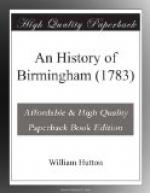The itch for building is predominant: we dip our fingers into mortar almost as soon as into business. It is not wonderful that a person should be hurt by the falling of a house; but, with us, a man sometimes breaks his back by raising one.
This private injury, however, is attended with a public benefit of the first magnitude; for every “House to be Let,” holds forth a kind of invitation to the stranger to settle in it, who, being of the laborious class, promotes the manufactures.
If we cannot produce many houses of the highest orders in architecture, we make out the defect in numbers. Perhaps more are erected here, in a given time, than in any place in the whole island, London excepted.
It is remarkable, that in a town like Birmingham, where so many houses are built, the art of building is so little understood. The stile of architecture in the inferior sort, is rather showy than lasting.
The proprietor generally contracts for a house of certain dimensions, at a stipulated price: this induces the artist to use some ingredients of the cheaper kind, and sometimes to try whether he can cement the materials with sand, instead of lime.
But a house is not the only thing spoilt by the builder; he frequently spoils himself: out of many successions of house-makers, I cannot recollect one who made a fortune.
Many of these edifices have been brought forth, answered the purposes for which they were created, and been buried in the dust, during my short acquaintance with Birmingham. One would think, if a man can survive a house, he has no great reason to complain of the shortness of life.
From the external genteel appearance of a house, the stranger would be tempted to think the inhabitant possessed at least a thousand pounds; but, if he looks within, he sees only the ensigns of beggary.
We have people who enjoy four or five hundred pounds a year in houses, none of which, perhaps, exceed six pounds per annum. It may excite a smile, to say, I have known two houses erected, one occupied by a man, his wife, and three children; the other pair had four; and twelve guineas covered every expence.
Pardon, my dear reader, the omission of a pompous encomium on their beauty, or duration.
I am inclined to think two thirds of the houses in Birmingham stand upon new foundations, and all the places of worship, except Deritend Chapel.
About the year 1730, Thomas Sherlock, late Bishop of London, purchased the private estate of the ladies of the manor, chiefly land, about four hundred per annum.
In 1758, the steward told me it had increased to twice the original value. The pious old Bishop was frequently solicited to grant building leases, but answered, “His land was valuable, and if built upon, his successor, at the expiration of the term, would have the rubbish to carry off:” he therefore not only refused, but prohibited his successor from granting such leases.




